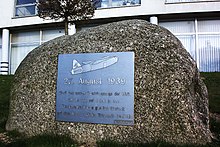Heinkel He 178
| Heinkel He 178 | |
|---|---|
 Heinkel He 178 |
|
| Type: | Experimental airplane |
| Design country: | |
| Manufacturer: | |
| First flight: |
August 27, 1939 |
| Commissioning: |
no |
| Number of pieces: |
1 |
The Heinkel He 178 was a test aircraft from the Ernst Heinkel Flugzeugwerke . It was the first airplane in the world to be powered by a jet engine. The first jet-powered flight was carried out on August 27, 1939, a few days before the start of the Second World War , by test pilot Erich Warsitz in Rostock-Marienehe . It lasted about eight minutes.
history

development
The development of the He 178 was a purely privately financed company-owned project by Heinkel Flugzeugwerke in Rostock-Marienehe, personally driven by Ernst Heinkel's passion for the development of new technologies for high-speed aircraft engines.
As early as 1936 he had made the resources of his company available to the physicist Hans Joachim Pabst von Ohain after he was able to convince him of the concept of his turbine jet propulsion. In the beginning, Ohain's engine development was marked by many setbacks, which also put a heavy financial burden on the aircraft factories. After a long test phase, Ohain finally created a safe and reliable unit with the HeS 3 engine, which was built into the He 178 specially developed for this purpose.
construction
The He 178 was designed as a single-engine aircraft. The aircraft was a shoulder- wing aircraft with a conventional retractable landing gear. This makes the He 178 one of the few types of jet aircraft with a tail wheel . The hull was made of duralumin sheet metal in a shell construction. The wings were made of wood. An asbestos coating should protect the affected wooden parts from the heat of the engine. The air for the engine was sucked in through a large opening in the nose of the fuselage, passed through a duct under the cockpit into the engine installed in the center of the fuselage and expelled through a conical thrust tube at the stern.
Flight performance
Although only a relatively low thrust was achieved on the first flight, the He 178 achieved a considerable increase in speed compared to conventional aircraft with piston engines . However, the Reich Aviation Ministry (RLM) had no interest in series production of the aircraft, which was unsuitable for operational purposes due to its short range, and had already ordered the development of a twin- engine fighter aircraft under the designation He 180 (later realized as the Heinkel He 280 ) before the first flight of the He 178 . The order for a parallel design went to Messerschmitt .
Technical specifications

| Parameter | Data |
|---|---|
| crew | 1 |
| length | 7.48 m |
| span | 7.20 m |
| height | 2.10 m |
| Wing area | 9.1 m² |
| Wing extension | 5.7 |
| Empty mass | 1620 kg |
| Takeoff mass | 2000 kg |
| Top speed | 700 km / h at sea level |
| Range | 200 km (theoretical) |
| Flight time | 8 min (reached) |
| Engine | a HeS 3B with 550 kp static thrust |
Whereabouts
The flight tests were discontinued after only twelve test flights. Until the end of the war, the aircraft was in the Rostock plant, where it was destroyed by a bomb attack. A second prototype was still being completed, but was no longer used for flight testing due to the lack of interest on the part of the RLM.
A replica of the Heinkel He 178 is in the exhibition on the history of aviation in the terminal of Rostock-Laage Airport and in the PhanTECHNIKUM Wismar .
See also
literature
- Volker Koos: On the history of aircraft construction in Mecklenburg. The development of the first He 178 jet aircraft . Rostock 1986, pp. 64-69 (In: Mecklenburgische Personalitäten and their contributions to scientific-technical progress in history. Issue 13 of the series Rostocker Wissenschaftshistorische Manuskripte , edited by the section History of the Wilhelm- Pieck University Rostock)
- Roger Ford: The German Secret Weapons of World War II. Edition Dörfler in Nebel-Verlag, Eggolsheim, ISBN 3-89555-087-6 .
- Lutz Warsitz: Flight captain Erich Warsitz - the first jet aircraft pilot in the world. Books on Demand, Norderstedt 2006, ISBN 3-8334-5378-8
- Lutz Warsitz: The First Jet Pilot - The Story of German Test Pilot Erich Warsitz. Pen and Sword Books, England 2008, ISBN 978-1-84415-818-8
Web links
- Aerial archive
- firstjetpilot.com Website about Erich Warsitz and the Heinkel He 178, with video and audio sequences as well as pictures
- Video of the first flight
Individual evidence
- ^ Hans Joachim Ebert: Pabst, Hans Joachim. In: New German Biography (NDB). Volume 19, Duncker & Humblot, Berlin 1999, ISBN 3-428-00200-8 , pp. 742 f. ( Digitized version ).
- ^ Heinz Nowarra: The German Air Armament 1933-45. Volume 2, ISBN 3-7637-5466-0 , p. 233.


